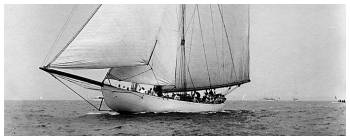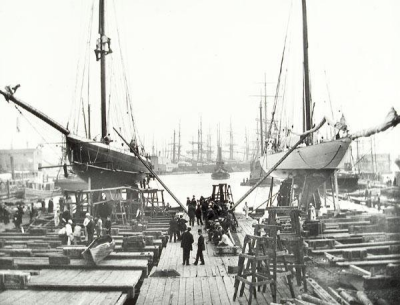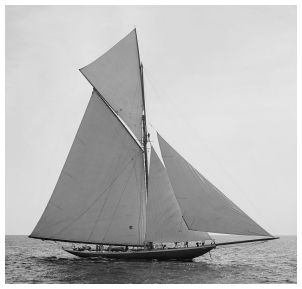Yves GARY Hits: 6218
Category: JUBILEE
 For the defense of the second Dunraven challenge, Boston, though its great designer Burgess was gone, entered the field valiantly and produced two boats of radical style, Jubilee and Pilgrim. Both were fin keels, a type that had been tried in smaller boats, but was as yet an unknown quantity in so large a craft as a ninety-footer.
For the defense of the second Dunraven challenge, Boston, though its great designer Burgess was gone, entered the field valiantly and produced two boats of radical style, Jubilee and Pilgrim. Both were fin keels, a type that had been tried in smaller boats, but was as yet an unknown quantity in so large a craft as a ninety-footer.
Jubilee was owned by Gen. Charles J. Paine, and was built of steel, from designs by Gen. Paine and his son, John B. Paine, by George Lawley & Son, of South Boston.
 Jubilee was launched at Lawley's City Point yard on June 24 at 7:25 morning. The launch was in every way a successful one, and was witnessed by several hundred people. There was little enthusiasm, though, and no demonstration. Gen. Paine was not present, but his wife and daughter were, and also his son, John B. designer of the boat.
Jubilee was launched at Lawley's City Point yard on June 24 at 7:25 morning. The launch was in every way a successful one, and was witnessed by several hundred people. There was little enthusiasm, though, and no demonstration. Gen. Paine was not present, but his wife and daughter were, and also his son, John B. designer of the boat.
The Jubilee is built of steel throughout, and is probably the lightest in construction of any or the only defenders. Her principal dimensions are: Length over all, 123 feet; length on water line, 84 feet; beam, 22 feet 6 inches; draught of hull, 4 feet 6 inches; depth of fin, 9 feet; total draught, 13 feet 6 inches.
The fin is made or steel plates and is hollow. It is about 40 feet long where it joins the hull and about 80 feet on the bottom. Its forward end has an easy slope upward, but the after end is straight up and down. In the centre or the fin is a centerboard about at dozen feet long and with a drop of 9 feet. It is a steel plate 1 1/8 inches thick, and is worked from the deck by a powerful winch. It does not come above the keel plate of the hull. Forward or the fin is a small centreboard which is 3 feet wide and which can be dropped straight down to aid in steering the boat if she should prove uneasy on her helm.
 The rudder is a steel one and hangs on a triangular steel “skeg" abaft the fin. It is about 8 feet long on the post and 3 feet wide in its widest part. The greater portion of the boat's ballast is carried in a bulb of lead at the bottom or the ?n. This bulb is somewhat cigar-shaped and weighs about thirty-two tons. It projects about two feet aft of the fin and is about 2 1/2 feet wide. Some five or six tons of lead have been run into the hollow fin forward and aft of the centreboard box, so that the total or the lead ballast is well toward forty tons.
The rudder is a steel one and hangs on a triangular steel “skeg" abaft the fin. It is about 8 feet long on the post and 3 feet wide in its widest part. The greater portion of the boat's ballast is carried in a bulb of lead at the bottom or the ?n. This bulb is somewhat cigar-shaped and weighs about thirty-two tons. It projects about two feet aft of the fin and is about 2 1/2 feet wide. Some five or six tons of lead have been run into the hollow fin forward and aft of the centreboard box, so that the total or the lead ballast is well toward forty tons.
The boat's sail plan will be very liberal, with a greater area of canvas on it than is carried by the Navahoe. The mast and main boom are of Oregon pine, and the bowsprit, topmast and lighter spars of spruce. All the spars, except the mast and bowsprit are hollow.
The interior accommodations will be ample, but not elaborate and everything will be as light as possible. This interior work is well along and will be done within a week. The yacht is painted white above the waterline and red below.
Jubilee has grown focusing difficult and it will not shine in the defender selection trials. In subsequent years, General Paine hesitate much about the follow-up and Jubilee will never have the career that his design would have deserved. He will undergo many transformations without ever convincing and demolished in 1911.
It will take almost a century, in 1991, that the idea of Jubilee is shot on a sailboat for a new generation, Wallygator, designed by Luca Brenta.
Download DELFTSHIP LINES : Delftship file to finish and background images
